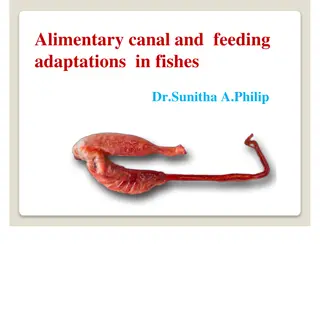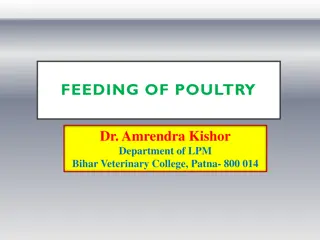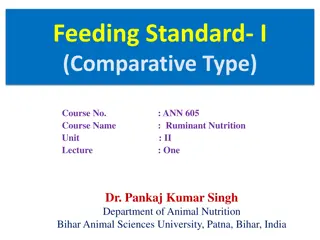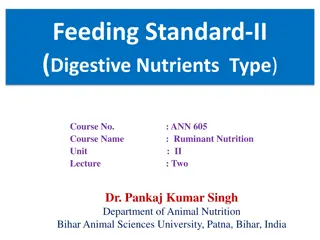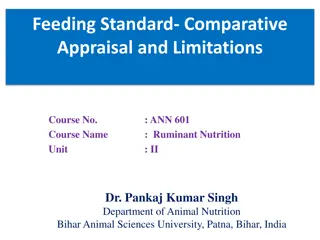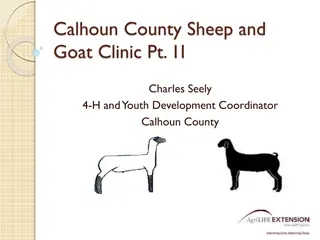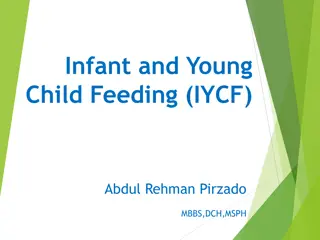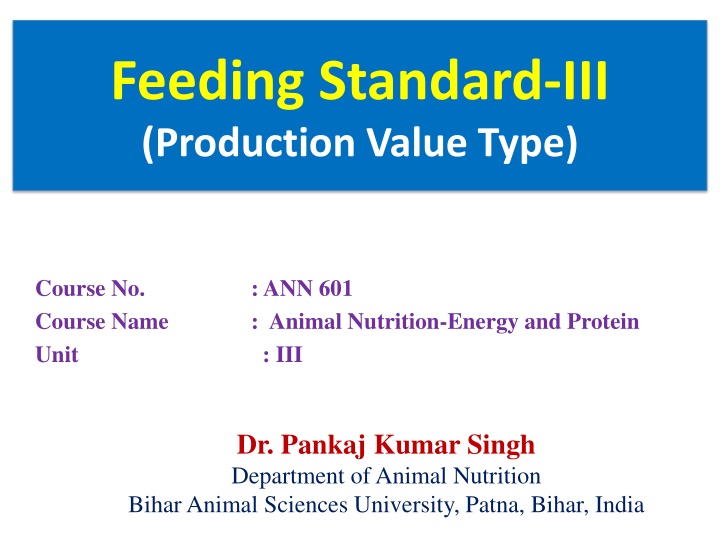
Animal Nutrition Feeding Standards and Energy Evaluation Methods
Explore the historical development of animal feeding standards and energy evaluation methods by Kellner and Armsby. Learn about the objectives of feeding standards and the significance of proper ration selection for livestock. Discover how these standards analyze energy requirements and balance nutrient intake for optimal animal nutrition.
Download Presentation

Please find below an Image/Link to download the presentation.
The content on the website is provided AS IS for your information and personal use only. It may not be sold, licensed, or shared on other websites without obtaining consent from the author. If you encounter any issues during the download, it is possible that the publisher has removed the file from their server.
You are allowed to download the files provided on this website for personal or commercial use, subject to the condition that they are used lawfully. All files are the property of their respective owners.
The content on the website is provided AS IS for your information and personal use only. It may not be sold, licensed, or shared on other websites without obtaining consent from the author.
E N D
Presentation Transcript
Feeding Standard-III (Production Value Type) Course No. Course Name Unit : III : ANN 601 : Animal Nutrition-Energy and Protein Dr. Pankaj Kumar Singh Department of Animal Nutrition Bihar Animal Sciences University, Patna, Bihar, India
Objectives of Feeding Standards To Guide Farmers to selecting properly balanced rations for their livestock. To classify different physiological functions like growth , maintenance , lactation , egg production and wool growth. Considering individual animal for preparation of FS due to their ability to digest and utilize feed.
Feeding Standard-III (Production Value Type) 1 Kellner feeding standard In 1907 Kellner, a German scientist investigated a feeding standard based upon Starch as the unit of measurement. He took into account not only the digestibility of the feeds as calculated from the amount lost in faeces and urine but also the entire loss from the body including energy expended in digestion and passing the food inside the body (chewing, etc.).
For measuring the amount of energy lost from the body as heat, Kellner devised a respiration apparatus. Here heat in determined indirectly by finding the amount of carbon dioxide gas liberated or by measuring the amount of oxygen gas used up in oxidation which take place in the body. According to this system, a 1,000 lbs. animal needs 0.6 lb. of digestible protein and 6.35 lbs. of starch equivalent. This starch equivalent in turn can be converted into energy by a method worked out by Armsby and Kellner. Any of the feeds the composition of which known be converted to starch equivalent by using the following factors:
Armsby feeding standard Armsby standard (1917) is based on true protein and net energy values. By means of the respiration calorimeter, Armsby determined the net energy required for mastication, digestion, assimilation and also the amount of heat and gases given off through the excretory channels. Thus after considering the various losses of energy such as in urine, faeces, gases and in the work of digestion, he was able to estimate the amount of net energy available for productive purposes. Armsby expresses his standard in two factors, that is true protein and therms of net energy.
A common criticism of the Armsby standard is that the expense of determining requirements of the animals and the net energy in the various feeds is excessively high. The net energy values of only a very few feeds had actually been determined and most of the values have been computed from the Table of Morrison s digestible nutrients. Armsby standard is not as widely used as are the standards based on digestible nutrients.
Agricultural Research Council (A.R.C.) standard In United Kingdom a technical committee was set up to develop the standards in 1959, by the Agricultural Research Council (ARC), which later came to be known as Agricultural and Food Research Council (AFRC). Requirements are set forth in three separate reports dealing with poultry, ruminants and pigs, each of these reports are extensive summaries of the literatures upon which the requirements are based. For ruminants, protein requirements are expressed in terms of metabolisable protein (g) and energy in term of metabolisable energy (MJ).
Agricultural Research Council (A.R.C.) standard For horse, protein requirements are expressed in terms of crude protein (g) and energy in term of digestible energy (MJ). For pigs, protein requirements are expressed in terms of standarised illeal digestible amino acid (g) and energy in term of net energy (MJ). For poultry, protein requirements are expressed in terms of crude protein (g) and energy in term of metabolisable energy (MJ).
6.4 References Agricultural and Food Research Council (AFRC) 1992 Technical Committee on Responses to Nutrients, report no. 5. Nutrient Requirements of Ruminant Animals: Energy, Farnham Royal, Commonwealth Agricultural Bureaux. Bondi A (1987). Animal Nutrition. Wiley Inter Science. Cramptan EW and Harris LE. (1969). Applied Animal Nutrition. WH Freeman. Maynard, L. A., Loosli, J.K., Hintz, H. F. and Warner, R. G. (1979). Animal Nutrition. 7thEd, McGraw-Hill, New York. Mc Donald P., Edwards R.A., Greenhalgh, J.F.D., Morgan, C.A., Sinclair, L.A and Wikinson, R.G (2010). Animal nutrition. 7th edn. Prentice Hall, Harlow, Essex, UK Ponds WG, Church DC, Pond KR and Schoknecht PA. (2005). Basic Animal Nutrition and Feeding. Wiley Dreamtech India.
Limitation of feeding standards Feeding standard is not a complete guide to feeding because other factors such as palatability and the physical nature of the ration are not taken into account. Feeding standards are only approximately correct. The amounts of nutrients recommended in the table of feeding standards are intended to be sufficient to meet the food requirements of maximum production. Environment may change nutrient requirements. Feeding standard does not consider economics of livestock production. Feeding standards based on assigned nutritive values (e.g., net energy) are misleading when unconventional feed resources are used. Feeding standards are not permanent, but are reexamined with change s in technology and production targets.
Usefulness of feeding The feeding standard consist of the quantity of nutrients required by an animal to remain healthy and highly productive. Feeding standards are set in accordance with productivity (milk, meat, wool, eggs), comp osition of the product (fat content of milk), and physiological condition (growth, fetal dev elopment). Consideration is also given to varying regional conditions in feeding standard. Feeding standards serves as guides in feeding animals and in estimating the adequacy of feed intake and of feed supplies for groups of animal. Feeding standards are bases for feeding systems which should allow effective and profitable nutritional management of animals appropriate to the prevailing nutritional, economic and sociological environment.
Merits and demerits of various feeding standards TDN and DE systems Merits TDN is a measure of apparent DE but is expressed in units of weight or % rather than energy per SE. TDN value provides a relative measure of the DE content of feed; 1 kg TDN = 4.409 Mcal DE. It is easy to determine the TDN content of feedstuffs; proximate composition of feeds and faeces and digestion trial are to be done. Digestible energy can readily be determined by using a bomb calorimeter to measure the GE of feed and faeces. No chemical analyses are required.
TDN and DE systems Demerits TDN system takes into account only the losses of nutrients in the faeces but not the other losses from the body. TDN system over evaluates the energy value of poor quality roughages in relation to concentrates specially so in hot environment because TDN does not consider large amounts of energy wasted in the digestion of fibrous feeds in the form of gases and heat increment andEther extract of forages largely comprise other than true fat. So a kg of TDN in roughage has less value for productive purpose than a kg of TDN in concentrate. Certain species of forage were found to have high gross energy and high TDN values due to essential oils but low ME values. The measurement of DE takes into account the losses only through faeces.
SE and ME systems Merits of ME system ME represents a more accurate measure since losses in urinary and gaseous products of digestion are also accounted for. ME provides a more satisfactory measure of nutritive value than do TDN or DE. ME is cheaper and easier to obtain than NE values. The efficiency of utilization of ME takes into consideration the purpose for which it is fed, level of feeding and caloric density of the diet.





